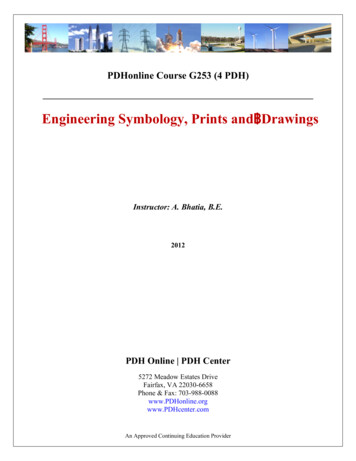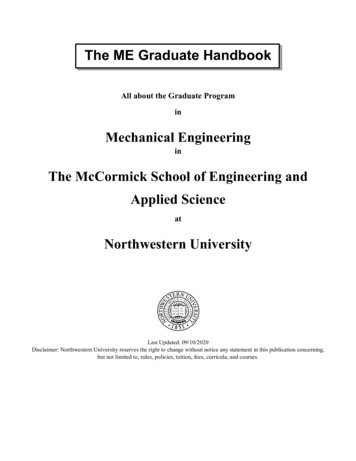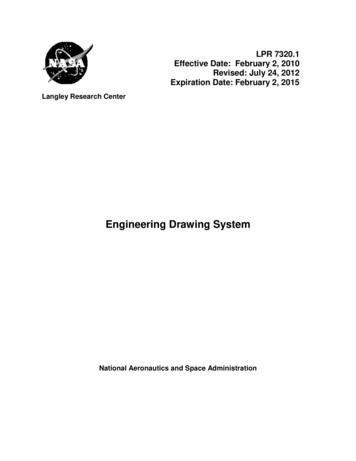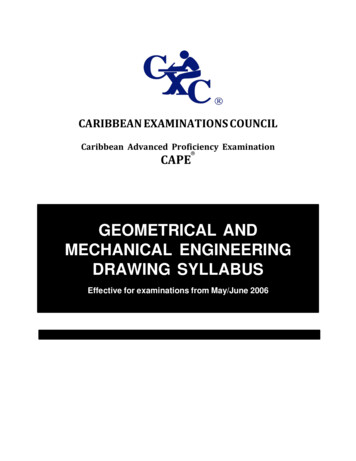
Transcription
CARIBBEAN EXAMINATIONS COUNCILCaribbean Advanced Proficiency ExaminationCAPE GEOMETRICAL ANDMECHANICAL ENGINEERINGDRAWING SYLLABUSEffective for examinations from May/June 2006CXC A22/U2/05
Published by the Caribbean Examinations CouncilAll rights reserved. No part of this publication may be reproduced, stored in a retrieval system, ortransmitted in any form, or by any means electronic, photocopying, recording or otherwise without priorpermission of the author or publisher.Correspondence related to the syllabus should be addressed to:The Pro-RegistrarCaribbean Examinations CouncilCaenwood Centre37 Arnold Road, Kingston 5, Jamaica, W.I.Telephone: (876) 630-5200Facsimile Number: (876) 967-4972E-mail address: cxcwzo@cxc.orgWebsite: www.cxc.orgCopyright 2005 by Caribbean Examinations CouncilThe Garrison, St Michael BB14038, BarbadosCXC A22/U2/05ii
ContentsRATIONALE . 1AIMS . 1 - 2SKILLS AND ABILITIES TO BE ASSESSED . 2PRE-REQUISITES OF THE SYLLABUS . 2STRUCTURE OF THE SYLLABUS . 3UNIT 1: GEOMETRICAL AND ENGINEERING DRAWINGMODULE 1: PLANE GEOMETRY . 4 - 8MODULE 2: SOLID GEOMETRY . 9 - 11MODULE 3: ENGINEERING DRAWING . 12 - 14UNIT 2: MECHANICAL ENGINEERING DRAWING AND DESIGNMODULE 1: MECHANICS OF MACHINES . 15 - 18MODULE 2: ENGINEERING MATERIALS AND PROCESSES . 19 - 22MODULE 3: ENGINEERING DESIGN ELEMENTS . 23 - 25OUTLINE OF ASSESSMENT . 26 - 40REGULATIONS FOR PRIVATE CANDIDATES. 40REGULATIONS FOR RESIT CANDIDATES . 40- 41ASSESSMENT GRID . 41REFERENCE MATERIAL . 41MINIMUM EQUIPMENT LIST. 42CXC A22/U2/05
This 2-Unit syllabus CXC A22/U2/05 replaces the 1-Unit syllabus CXC A22/U1/02issued in 2002.First Issued 1999Revised 2002Revised 2005Please check the website, www.cxc.org for updates on CXC’s syllabuses.CXC A22/U2/05ii
T3IntroductionThe Caribbean Advanced Proficiency Examination (CAPE) is designed to provide certification ofthe academic, vocational and technical achievement of students in the Caribbean who, havingcompleted a minimum of five years of secondary education, wish to further their studies. Theexaminations address the skills and knowledge acquired by students under a flexible and articulatedsystem where subjects are organised in 1-Unit or 2-Unit courses with each Unit containing threeModules. Subjects examined under CAPE may be studied concurrently or singly.The Caribbean Examinations Council offers three types of certification. The first is the award of a certificateshowing each CAPE Unit completed. The second is the CAPE diploma, awarded to candidates who havesatisfactorily completed at least six Units, including Caribbean Studies. The third is the CAPE AssociateDegree, awarded for the satisfactory completion of a prescribed cluster of seven CAPE Units includingCaribbean Studies and Communication Studies. For the CAPE diploma and the CAPE Associate Degree,candidates must complete the cluster of required Units within a maximum period of five years.Recognized educational institutions presenting candidates for CAPE Associate Degree in one of the ninecategories must, on registering these candidates at the start of the qualifying year, have them confirm in therequired form, the Associate Degree they wish to be awarded. Candidates will not be awarded any possiblealternatives for which they did not apply.CXC A22/U2/05
Geometrical and MechanicalEngineering Drawing Syllabus RATIONALEGeometrical and Mechanical Engineering Drawing (GMED) is the universal means of communicationfor engineers, technicians and craftsmen. This type of international communication is facilitated bythe use of standards published by the International Organization for Standardization (ISO) forEngineering Drawing.The course of study for GMED comprises both practical and theoretical activities that respond to theinterests, skills and disposition of students within a wide range of abilities. This subject stimulates aninterest in drafting and engineering as career options for students. GMED incorporates the language andlogic that structurally link a wide range of occupations and is, therefore, important in creating anddeveloping the infrastructure necessary for socio-economic development of the Caribbean region.The course outlined in this syllabus would enhance the capabilities and skills of students and promotestheir development as rational, ethical and responsible members of society. Unit 1 focuses on thepreparation of engineering drawings, while Unit 2 focuses on the design and drawing of engineeringcomponents. A student who completes this syllabus would be competent in the use of the latestdevelopments in drawing technology, including Computer-Aided Drafting (CAD). In addition, the studentwould become proficient in the application of the British Standards (BS 8888), ISO Standards, CaribbeanUniform Building Codes (CUBiC) and local codes.The syllabus also contributes to the development of selected attributes from the CARICOM Ideal Person document asarticulated by the CARICOM Heads of Government. This person is one who demonstrates emotional security with a high levelof self-confidence and self-esteem, is aware of the importance of living in harmony with the environment and nurtures itsdevelopment in the economic and entrepreneurial spheres in all other areas of life (CARICOM Education Strategy, 2000).This holistic development of students aligns with selected competencies advocated in the UNESCO Pillars of learning. These arelearning to be, learning to do, and learning to transform one’s self and society. AIMSThe syllabus aims to:1.develop skills in the reading, interpretation and production of Mechanical Engineering drawingsand diagrammatic illustrations conforming to BS and ISO Standards, CUBiC and local codes;CXC A22/U2/051
2.develop skills in the preparation of working and assembly drawings conforming to BS and ISOStandards, CUBiC and local codes;3.provide knowledge of materials for production of engineering components;4.provide knowledge of the different methods of production of engineering components;5.develop skills in applying the principles of Geometrical and Mechanical Engineering Drawing insolving engineering problems;6.develop skills in applying and drawing principles to facilitate product development andmanufacture;7.develop skills to use Computer-Aided Drafting (CAD) software to produce engineering drawings;8.develop an interest in Mechanical Engineering as a career and as an intellectual discipline;9.develop an appreciation of the pivotal role of Mechanical Engineering drawing in the socioeconomic development of individual territories and the Caribbean region as a whole. SKILLS AND ABILITIES TO BE ASSESSEDThe skills and abilities which students are expected to develop on completion of the syllabus have beengrouped under three headings:(i)(ii)(iii)Knowledge;Application; andDrawing Skills.Knowledge:The ability to identify, recall and grasp the meaning of basic facts, concepts andprinciples.Application:The ability to use facts, concepts, principles and procedures in unfamiliarsituations; transform data accurately and appropriately; usecommoncharacteristics as a basis for classification; use formulae accurately forcomputations.Drawing Skills:The ability to produce neatly organized, clean and accurate drawings according tospecification. PRE-REQUISITES OF THE SYLLABUSIt is expected that persons with a good grasp of the Mechanical Engineering Drawing Option of the CSECTechnical Drawing syllabus or the equivalent should be able to successfully pursue this course.CXC A22/U2/052
STRUCTURE OF THE SYLLABUSThe syllabus is divided into two Units. Each Unit consists of three Modules. The Units are independent ofeach other. Together they provide a comprehensive post-secondary course in the field of EngineeringCommunication.Unit 1: Geometrical and Engineering Drawing contains three Modules of approximately 50 hours each. Thetotal time for the syllabus is approximately 150 hours.Module 1Module 2Module 3-Plane GeometrySolid GeometryEngineering DrawingUnit 2: Mechanical Engineering Drawing and Design contains three Modules of approximately 50 hourseach. The total time for the syllabus is approximately 150 hours.Module 1Module 2Module 3-CXC A22/U2/05Mechanics of MachinesEngineering Materials and ProcessesEngineering Design Elements3
UNIT 1: GEOMETRICAL AND ENGINEERING DRAWINGMODULE 1: PLANE GEOMETRYGENERAL OBJECTIVESOn completion of this Module, students should:1.develop the ability to produce drawings of a two-dimensional nature;2.develop basic Computer-Aided Drafting (CAD) skills.SPECIFIC OBJECTIVESStudents should be able to:1.define standard engineering curves;2.construct standard engineering curves;3.determine centroids of plane figures by graphical methods;4.use graphical methods of integration of areas and first and second moment of areas;5.develop displacement diagrams for edge, face and cylindrical Cams;6.develop Cam profiles;7.use Computer-Aided Drafting software to produce drawings.CONTENT1.Conic Sections and Loci(i)Standard engineering curves: ellipse, parabola, hyperbola, Archimedean spiral andinvolute.(ii)Construction of ellipse, parabola and hyperbola using true methods.(iii)Construction of Archimedean spiral, involute and cycloid.(iv)Construction of tangents to these curves.CXC A22/U2/054
UNIT 1MODULE 1: PLANE GEOMETRY (cont’d)2.Centroids(i)3.Graphical methods:(a)integration of area;(b)first and second moments.Cams(i)(ii)(iii)Construction of Cam profiles and displacement diagrams to produce:(a)dwell;(b)uniform velocity;(c)uniform acceleration or retardation;(d)simple harmonic motion.Construction of Cam profiles and displacement diagrams with various types of d)spherical.Construction of Cam profiles and displacement diagrams with different follower paths:(a)straight line;(b)circular arc;(c)on-centre;(d)off-centre.CXC A22/U2/055
UNIT 1MODULE 1: PLANE GEOMETRY (cont’d)4.Computer-Aided Drafting (CAD)(i)Use of Cartesian, Polar and Absolute co-ordinates.(ii)CAD features:(iii)(iv)(a)menus;(b)toolbars (draw, modify, dimension);(c)parameters.toolbars:(a)draw – line;(b)construction ndary.modify:(a)mirror;(b)array (rectangle, polar);CXC A22/U2/056
UNIT 1MODULE 1: PLANE GEOMETRY sion text edit;(m)dimension style.Use of CAD software to produce plane geometry drawings.CXC A22/U2/057
UNIT 1MODULE 1: PLANE GEOMETRY (cont’d)Suggested Teaching and Learning ActivitiesTeachers are encouraged to engage students in activities such as those listed below as they seek to achievethe objectives of this Module.1.Have students solve problems pertaining to the Content on Plane Geometry in the recommendedtexts.2.Use real life examples to promote class discussion and illustrate the use and purpose of PlaneGeometry in Mechanical Engineering.3.Explain the fundamentals of Mechanical Engineering science with emphasis on definitions and thegraphical approach.4.Place emphasis on freehand sketching and different drawing methods.5.Have students perform relevant calculations where required.6.Have students use CAD software to produce Plane Geometry drawings.RESOURCEHewitt, D.E.CXC A22/U2/05Engineering Drawing and Design for Mechanical Technicians, London:The Macmillian Press Limited, 1999.8
UNIT 1MODULE 2: SOLID GEOMETRYGENERAL OBJECTIVESOn completion of this Module, students should:1.develop the ability to produce three dimensional drawings;2.develop Computer-Aided Drafting (CAD) skills.SPECIFIC OBJECTIVESStudents should be able to:1.represent solids in pictorial projections;2.apply the isometric scale in constructing drawings in isometric projection;3.construct circles and curves in pictorial drawings;4.project solids in orthographic projection;5.project sections of solids cut by inclined planes;6.draw true shapes of sections;7.project auxiliary views;8.draw lines of intersection between solids;9.develop surfaces of right or skewed objects;10.develop surfaces composed of multiple geometric shapes;11.arrange the development of surfaces to use material optimally;12.construct helix for appropriate applications;13.produce drawings using CAD software.CXC A22/U2/059
UNIT 1MODULE 2: SOLID GEOMETRY (cont'd)CONTENT1.Pictorial Projections(i)2.3.4.Projection of solids oint angular.(ii)The application of the isometric scale to the construction of drawings in isometricprojection.(iii)The construction of circles and curves in pictorial drawings.Orthographic Projections(i)First angle projection.(ii)Third angle projection.Auxiliary Views(i)The projection of sections of solids cut by inclined planes.(ii)True shapes of sections.(iii)First and second auxiliary views.Intersection of SolidsIntersection and interpenetration of solids.CXC A22/U2/0510
UNIT 1MODULE 2: SOLID GEOMETRY (cont'd)5.6.7.Surface Development(i)Surfaces of right or skewed three-dimensional objects.(ii)Surfaces composed of multiple geometric shapes.(iii)Transition pieces (square-to-round, round-to-round).(iv)Economical use of materials.Helix(i)Application of helix to screw threads and springs.(ii)Construction of helix on cylindrical and conical forms.CADUse of CAD software to produce solid geometry drawings.Suggested Teaching and Learning ActivitiesTeachers are encouraged to engage students in activities such as those listed below as they seek to achievethe objectives of this Module.1.Have students solve problems pertaining to the Content on Solid Geometry in the recommendedtexts.2.Use real life examples to promote class discussions and illustrate the use and purpose of SolidGeometry in Mechanical Engineering.3.Place emphasis on definitions, freehand sketching and different drawing methods.4.Have students perform relevant calculations where required.5.Have students use CAD software to produce Solid Geometry drawings.RESOURCEHewitt, D.E.CXC A22/U2/05Engineering Drawing and Design for Mechanical Technicians, London:The Macmillian Press Limited, 1999.11
UNIT 1MODULE 3: ENGINEERING DRAWINGGENERAL OBJECTIVESOn completion of this Module, students should:1.develop the ability to prepare machine drawings;2.develop the ability to produce drawings, freehand sketches and designs of machine components formanufacture.SPECIFIC OBJECTIVESStudents should be able to:1.prepare drawings with sectional views;2.produce working and assembly drawings;3.produce and dimension drawings of engineering components for manufacturing;4.prepare detailed freehand sketches of machine parts and components;5.synthesize solutions to simple engineering problems;6.produce drawings using CAD software.CONTENT1.2.Assembly Drawings(i)Assembly drawings of machine parts and components.(ii)Detailed drawings of components from: assembly drawings, freehand sketches and actualmachine parts.Working Drawings(i)Working drawings of machine parts and components.(ii)Use of welding and machine graphical symbols.CXC A22/U2/0512
UNIT 1MODULE 3: ENGINEERING DRAWING (cont'd)3.Detailed Drawings(i)(ii)4.Dimensional drawings:(a)manufacturing;(b)general;(c)geometric and positional tolerance: finishes, limits and fits (BS 4500).Balloon referencing and part listings:(a)cross-reference;(b)item list and materials specification.Freehand SketchingOrthographic and pictorial views of machine parts and components.5.DesignSynthesize designs using components selected from the suggested list below.(i)accessories: gauges, small tools and clamping devices;(ii)mechanisms: slide crank and pin, rack and pinion, ratchet;(iii)fasteners: bolts and nuts, screws, studs, keys, pins, rivets and locking devices;(iv)Hydraulic Systems:(a)pumps: centrifugal and reciprocating;(b)valves: non-return, isolating, expansion, safety, gate and globe;(c)piping and joints: flanged and hydraulic;(d)seals: dynamic and static.CXC A22/U2/0513
UNIT 1MODULE 3: ENGINEERING DRAWING (cont'd)(v)Machine tools:Parts of the following machines: drilling; grinding; lathe; milling and shaping.6.CADUse of CAD software to produce engineering drawings.Suggested Teaching and Learning ActivitiesTeachers are encouraged to engage students in activities such as those listed below as they seek to achievethe objectives of this Module.1.Use articles from current periodicals on relevant Mechanical Engineering topics to assist studentsin adequately covering the design sections of the Module.2.Have students complete several working and assembly drawings of machine parts and components.3.Place emphasis on the importance of freehand sketching to enable students to become familiarwith the complexity in the theory and construction of various machine parts and components.4.Visit a Mechanical Engineering Drawing Office to familiarize students with the differentconventional representation on drawings and the use and importance of drawing standards.5.Visit machine and mechanical engineering workshops to familiarize students with the operations.6.Arrange lectures by experienced engineers on the design and preparation of working drawings ofengineering components in order to enhance students’ understanding and appreciation of thecontent in the Module.RESOURCEHewitt, D.E.CXC A22/U2/05Engineering Drawing and Design for Mechanical Technicians, London:The Macmillian Press Limited, 1999.14
UNIT2:MECHANICALDESIGNENGINEERINGDRAWINGANDMODULE 1: MECHANICS OF MACHINESGENERAL OBJECTIVESOn completion of this Module, students should:1.understand how forces in structures are graphically determined;2.develop skills to produce accurate drawings of gear tooth profiles;3.understand how true lengths and angles of skew lines are determined;4.develop skills to locate planes in space;5.acquire knowledge of ISO conventional systems, British Standards (BS 8888), Caribbean UniformBuilding Codes (CUBiC) and local codes.SPECIFIC OBJECTIVESStudents should be able to:1.determine forces by graphical methods;2.construct shearing force and bending moments diagrams;3.determine forces in beams;4.calculate the various parameters of the involute spur gears;5.construct involute gear tooth profiles;6.use ISO conventional systems and British Standards (BS 8888);7.determine true angles;8.locate lines and planes in space;9.draw planes inclined to planes of reference;10.determine the perpendiculars from given oblique planes;11.determine the shortest distance between skew lines;CXC A22/U2/0515
UNIT 2MODULE 1: MECHANICS OF MACHINES (cont’d)12.produce drawings using Computer-Aided Drafting (CAD) software.CONTENT1.2.Systems of Forces by Graphical Methods(i)Triangle, parallelogram and polygon of forces to find resultant equilibrium; resolution offorces in members of simple framework.(ii)Space and polar diagrams and funicular (link) polygons to find the position of resultant orequilibrium.(iii)Shearing force and bending moment diagrams.Gears(i)Involute Spur Gears - definition of terms:(a)pitch circle diameter;(b)pitch point;(c)pressure ular pitch;(h)circular tooth thickness;(i)number of teeth;(j)diametrical pitch;(k)module;(l)base circle diameter.CXC A22/U2/0516
UNIT 2MODULE 1: MECHANICS OF MACHINES (cont’d)3.4.(ii)Calculation of parameters necessary for construction of gear tooth profiles.(iii)Construction of gear tooth profiles by involute and approximate methods.(iv)Use of ISO conventional systems and British Standards (BS 8888).Skew Lines(i)True angles between intersecting lines.(ii)True angles between intersecting planes.(iii)True angles between lines and planes.(iv)Traces of lines on planes.(v)Traces of planes on planes.(vi)Traces of perpendicular planes and their inclination to the planes of reference.(vii)Traces of oblique planes and their inclination to the planes of reference.(viii)Oblique plane and its inclination to the planes of reference.CADUse of CAD software to produce mechanics of machine drawings.Suggested Teaching and Learning ActivitiesTeachers are encouraged to engage students in activities such as those listed below as they seek to achievethe objectives of this Module.1.Use real life examples of components to illustrate the techniques contained in the Module.2.Visit a Mechanical Engineering Drawing Office to familiarize students with the differentconventional representation on drawings and the use and importance of drawing standards.3.Have students research and make presentations on topics contained in the Module.CXC A22/U2/0517
UNIT 2MODULE 1: MECHANICS OF MACHINES (cont’d)4.Have students use CAD software to produce drawings on Mechanics of Machines.RESOURCEHewitt, D.E.CXC A22/U2/05Engineering Drawing and Design for Mechanical Technicians, London:The Macmillian Press Limited, 1999.18
UNIT 2MODULE 2: ENGINEERING MATERIALS AND PROCESSESGENERAL OBJECTIVESOn completion of this Module, students should:1.understand the different methods of producing engineering components;2.acquire knowledge of materials for the production of engineering components;3.develop the ability to identify appropriate bearings for various applications;4.know appropriate lubricants and lubrication method for various applications;5.develop the ability to identify seals for various applications.SPECIFIC OBJECTIVESStudents should be able to:1.describe the appropriate manufacturing processes for the production of engineering components;2.select appropriate materials for the production of engineering components;3.solve problems requiring knowledge of the application of bearings;4.solve problems requiring knowledge of the application of lubricants;5.solve problems requiring knowledge of the application of seals.CONTENT1.Materials(i)Metals:(a)ferrous - wrought iron, cast iron, carbon steel, stainless steel;(b)non-ferrous – copper, aluminium, brass and other alloys.CXC A22/U2/0519
UNIT 2MODULE 2: ENGINEERING MATERIALS AND PROCESSES (cont’d)(ii)(iii)2.Plastics - manufactured material:(a)thermo-plastic – polyvinyl chloride (PVC), polytetrafluroethylene lene,polyamides(Nylon),polymethylmethacrylate (Perspex);(b)thermo-setting - epoxy-resin (bakelite, melamine, araldite), laminates (tufnol,formica).Rubber:(a)characteristics (organic, silicone, synthetic);(b)uses and applications.Manufacturing Processes(i)Machining Tool Operations - turning, shaping, drilling, milling and grinding.(ii)Casting – sand, die, investment.(iii)Forging – drop, hand (upsetting, drawing down, swaging, bending).(iv)Fabrication:(v)(a)welding – shielded metal arc welding (SMAW), oxyfuel gas welding (OFW), gastungsten-arc (GTAW), oxy-gas (acetylene);(b)welding symbols and their application;(c)riveting - cold, hot, pop;(d)steel metal work - grooved seam, knock-up, pandown, flanging, rolling andbending.Safety in Manufacturing:(a)safety equipment and material;(b)safety procedures and processes in manufacturing;(c)safety design in manufacturing.CXC A22/U2/0520
UNIT 2MODULE 2: ENGINEERING MATERIALS AND PROCESSES (cont’d)3.4.5.6.7.Bearings(i)Roller- cylindrical (radial, thrust), tapered, spherical, needle.(ii)Ball - radial, thrust, angular contact, self aligning, single/double row.(iii)Journal - pillow block, self lubricating.(iv)Typical applications.Bushing(i)Bush – drill, sleeve (limits and fits).(ii)Typical applications.Lubrication(i)Types of lubricants - liquid, solid and gas.(ii)Methods of applications - liquid (splash, pressurised); solid; gas (mist, air).Seals(i)Static - gasket, o-ring.(ii)Dynamic - labyrinth, split ring, ‘U’, garter spring, o-ring.CADUse of CAD software to produce drawings.Suggested Teaching and Learning ActivitiesTeachers are encouraged to engage students in activities such as those listed below as they seek to achievethe objectives of this Module.1.UNIT 2Use real life examples of components made from the manufacturing processes and materials inModule.CXC A22/U2/0521
MODULE 2: ENGINEERING MATERIALS AND PROCESSES (cont’d)2.Have students visit machine and mechanical engineering workshops to familiarize them with thevarious machine-tools, equipment and sub-assembly components being repaired.3.Have students visit engineering plants/factoriesto observe thecomponents/products using the various processes and materials in the Module.4.Have students research and make presentations on topics contained in the Module.manufactureRESOURCEHewitt, D.E.CXC A22/U2/05Engineering Drawing and Design for Mechanical Technicians, London:The Macmillian Press Limited, 1999.22of
UNIT 2MODULE 3: ENGINEERING DESIGN ELEMENTSGENERAL OBJECTIVESOn completion of this Module, students should:1.develop skills to synthesize or modify designs using creativity, technical information and scientificprinciples;2.develop skills to prepare freehand sketches and drawings of machine components suitable fordifferent manufacturing processes.SPECIFIC OBJECTIVESStudents should be able to:1.solve problems requiring knowledge of various elements of power transmission;2.prepare freehand sketches and drawings of machine components;3.explain the design process;4.produce or modify designs of machine parts and components.CONTENT1.Transmission of Motion and Power(i)Couplings - rigid, flanged, fluid, Oldham and universal point.(ii)Clutches - single plate, multi-plate and centrifugal.(iii)Gears - spur, helical, bevel and worm.(iv)Belt drives - vee, flat and toothed (tensioning of belts, fixed and movable shafts).(v)Brakes - single shoe, double shoe and internal drum.(vi)Chain drives – roller and inverted tooth/silent (tensioning of chain).CXC A22/U2/0523
UNIT 2MODULE 3: ENGINEERING DESIGN ELEMENTS (cont’d)2.Design detailsDesign for casting, forging, machining and fabrication.3.4.Design principles(i)Elements: materials specification, manufacturing processes, size and shape.(ii)Aesthetics and ergonomics (ergonomic control loop).(iii)Cost.Design processThe six stages:5.(i)recognition of need;(ii)definition of problem;(iii)synthesis;(iv)analysis and optimisation;(v)evaluation;(vi)presentation.CADUse of CAD software to design and produce engineering drawings.Suggested Teaching and Learning ActivitiesTeachers are encouraged to engage students in activities such as those listed below as they seek to achievethe objectives of this Module.1.Use articles from current periodical on relevant Mechanical Engineering topics to assist students inadequately covering the content in the Module.CXC A22/U2/0524
UNIT 2MODULE 3: ENGINEERING DESIGN ELEMENTS (cont’d)2.Have students complete a number of working and assembly drawings of various engineeringcomponents.3.Place emphasis on the importance of freehand sketching to enable students to become familiarwith the differences in the theory and construction of various devices.4.Have students visit a Mechanical Engineering Drawing Office to familiarize them with the differentconventional representation on drawings and the use and importance of drawing standards.5.Arrange lectures by experienced engineers with respect to the production of working drawings anddetailed designs in order to enhance students’ understanding and appreciation of the content inthe Module.6.Have students use CAD software to design and draw machine parts and components.RESOURCESHawkes, B and Abinett, R.The Engineering Design Process, Essex , United Kingdom: LongmanGroup Limited, 2000.Hewitt, D.E.Engineering Drawing and Design for Mechanical Technicians, London:The Macmillian Press Limited, 1999.CXC A22/U2/0525
OUTLINE OF ASSESSMENTEach Unit of the syllabus will be independently assessed and graded separately. The same scheme ofassessment will be applied to each Module in each Unit. Candidates have the option of submitting theirresponses to Paper 01 and Paper 02 using either the traditional drawing method (drawing board and teesquare) or Computer-Aided Drafting (CAD) software.EXTERNAL ASSESSMENT(80%)Written PapersPaper 01(2 hours)Nine compulsory tasks consisting of three questions fromeach Module in the Unit.30%Paper 02(3 hours)Nine essay or extended response questions (inclusive ofdrawings) arranged in three sections corresponding to thethree Modules of the Unit. Each section consists of threequestions. Candidates will be required to answer twoquestions from each section.50%INTER
Drawing Skills: The ability to produce neatly organized, clean and accurate drawings according to specification. PRE-REQUISITES OF THE SYLLABUS. It is expected that persons with a good grasp of the Mechanical Engineering Drawing Option of the CSEC Technical Drawing syllabus or the equi
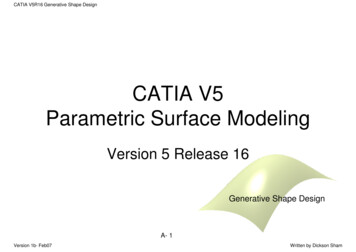
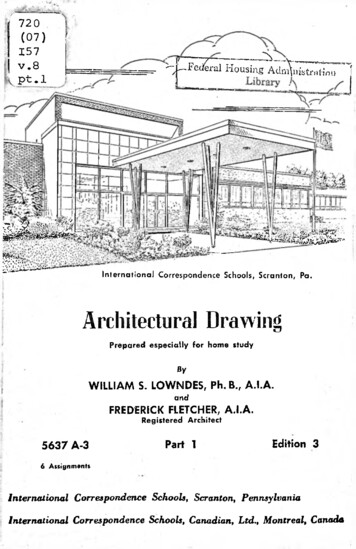
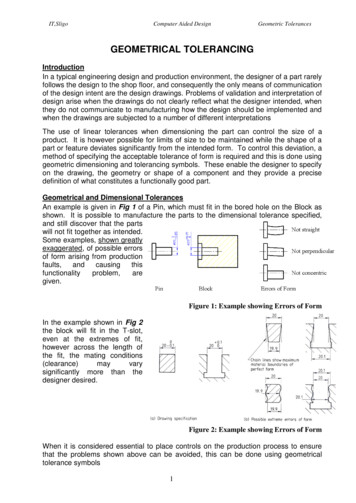
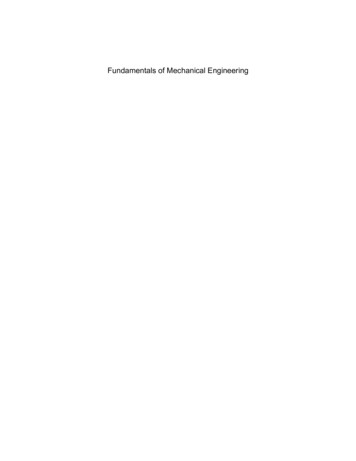


![Engineering Graphics Essentials [4th Edition]](/img/13/978-1-58503-610-3-1.jpg)

